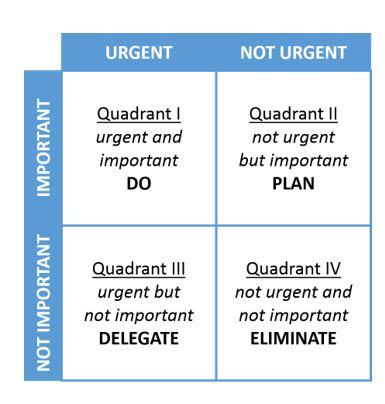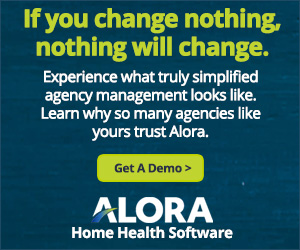
06 Sep Time is money…Maximizing workflow efficiency for nursing staff
In the home health care and home care industries, maximizing your agency’s time and efficiency is important for success. In this blog, we will review best practices and industry tips to make the most of your staff’s time.
Time Really is Money!
In an era where an agency’s financial disposition determines so much from an operational standpoint, you want your dollar to go farther. It’s important to use an agency management system that aligns with your mission, values, and goals. Here are some tips on how to maximize workflow efficiency for your staff, to make their lives easier:
- Make the shift to paperless workflow systems (Home Health Software, apps that allow visitation or other functional operations on the go, additional technologies that empower you to complete workflow faster and with less errors, and NO paper-trail)
- Have a plan for communication
- Use the “Eisenhower Box” as a time management planner
Make the shift to paperless workflow systems
According to a study completed in Shiraz University of Medical Sciences (SUMS), 16-34% of nurses and doctors believed that paper documentation was their most frequent preventable waste of time. In recent times, some states have even mandated that certain tasks must be recorded digitally.
If your nurses and caregivers are shuffling around from patient to patient with physical paper forms, you should consider making a transition to paperless workflows.
Using paper forms is minimizing your efficiency for a variety of reasons, including:
- Potential HIPAA violations
- If papers aren’t uploaded electronically, you have to rely on it being brought place to place
- Handwritten documents can be hard to read
By using electronic communication and documentation, it can be easily shared and accessible to relevant members of your care team.
If your caregivers are documenting care notes in a log at a patient’s home, those notes aren’t being conveyed to the office unless you pick them up. By transferring your documentation to a completely online format, you can ensure that your clinical team will be up-to-date on all changes in condition. It’s easy for papers to get lost in transit, within other non-work-related papers, under books, and blown away, but it’s impossible for electronic documents to be tossed around during everyday transit or in a breeze!
Have a plan for communication
Communication is a common issue for caregivers and nurses alike, and by having a plan, you can make sure that each member of your team will be caught up to speed on what their responsibilities are.
If you take on a new patient, have a communication workflow so that everyone knows when and how to communicate.
For example, if you want a 24-hour, 48-hour, and 1-week follow-up on a new admission, document these in a spreadsheet or document for your team to view. This way, you can assign tasks to each applicable member of your team and ensure that everyone is aware of how care is going.
This same communication can apply to new and existing caregivers. Whether you just hired a caregiver or you have a nurse that’s been with you for years, have a regular communication cadence with your staff members. Staff turnover in healthcare is much higher than in other industries, and communication is a critical component of employee success.
Use the “Eisenhower Box” as a time management planner
Maximize your nursing staff’s time by making sure that their tasks are relevant, timely, and completed in the most efficient way.
There is a concept called the “Eisenhower Box,” “Urgent-Important Matrix,” or “Eisenhower Matrix” designed by former president, Dwight D. Eisenhower, to manage productivity and time. This way of organizing time and tasks for your clinicians is critical to their efficiency and making sure that things are done in a timely manner.

This is an example of what the Eisenhower Box looks like.
The first quadrant consists of tasks that are urgent and important, which could include new patient admissions and urgent assessments caused by a change in a patient’s condition. These tasks should be done as soon as possible by a qualified nursing staff member.
The second quadrant consists of tasks that aren’t urgent but are important. Set a reminder to complete this task so that it doesn’t get swept under the rug, but there isn’t a need to rush on getting it done.
The third quadrant consists of tasks that are urgent but not important. See if these tasks can be delegated to another staff member. This can include faxing a paper, which can be completed by an office assistant or other member of your administrative team.
The fourth quadrant is meant to be eliminated; these are tasks that aren’t urgent or important. If possible, try to eliminate this task from this person’s workload. Maybe this was meant for someone else or doesn’t need to be on anyone’s immediate radar? Keep these questions in mind as you prioritize and delegate tasks to your nursing team.
These suggestions aren’t meant to be prescriptive, as there may be state or federal guidelines that prohibit certain tasks from being delegated or eliminated.
Your time is money, use it wisely
Educator and businessman, Stephen Covey once said, “The key is not spending time, but investing in it.”
If you want to invest in time, the best way to maximize it is to complete tasks in the most efficient and productive way. Use these tips to make sure that your clinical team members are doing tasks that are important and urgent while placing less emphasis on other tasks that don’t take such priority. By taking care of your team in this way, it’ll show that you care and have a permanent interest in respecting your team’s time, effort, and credentials.
Author’s Note: Views, information, and guidance in this resource are intended for information only. We are not rendering legal, financial, accounting, medical, or other professional advice. Alora disclaims any liability to any third party and cannot make any guarantee related to the content.

Home Health software is a proven tool for communications improvement, higher workflow efficiency, and compliance with state and federal mandates. Want more information on how paperless workflow can benefit your agency? Click here




No Comments